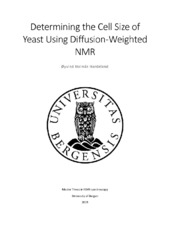| dc.description.abstract | Abstract This study uses diffusion weighted NMR to determine yeast cell size at different times after those cells were suspended in water. Both the water diffusion and the metabolite diffusion where used in those measurements. Diffusion weighted NMR is a well-studied noninvasive tool that can be used to study various microstructures. Yeast is a cheap and versatile model system for more complex biological systems. To measure the metabolites they first had to be identified in the NMR spectrum of the yeast cells suspensions. The identification was done by extracting the metabolites from the yeast cells using ethanol. This allowed for identification of several specific metabolite signals, although there was still a lot of overlapping signals in the spectrum that could not be identified. Dried yeast, of the species Saccharomyces Cerevisiae, was washed and suspended in a 10 % D2O phosphate buffer. These suspensions were measured using several PFGSE NMR experiments, with varying diffusion times, and with and without water suppression. The data from these measurements were used to determine time dependent diffusion coefficients. Because of the restrictions on the diffusion of molecules due to the cell wall, there is a decline in time dependent diffusion coefficient with increasing diffusion time, and this decline can be used to determine the cell size. The metabolite measurements of cell size in the yeast samples show apparent growth from around 1,9 μm at 3 days suspended to around 3,5 μm at 12 days suspended. The intracellular water signal did not show this growth, staying around 1,6 μm. These values all fit within a reasonable range of known values for the cell radius of Saccharomyces Cerevisiae yeast, which is between 1,9 and 3,3 μm. [31] The growth in cell size can be attributed to the cells actually swelling, or to the cells dying and the cell walls becoming more permeable. The lack of growth in the water signal means that the water signal is likely less sensitive towards changes in microstructure. This might be because of influence from the extracellular water signal, or because there is less relative change in cell membrane permeability, as water already had comparatively rapid cell membrane exchange, as compared to the metabolites Cell size was also measured in a layered sample using slice selective measurements. One layer had yeast that had been suspended 12 days and the other had yeast that had been suspended 3 days. The slice selective diffusion measurements gave cell sizes that were larger than the cell sizes from the non-selective measurements, around 4 μm. It is difficult to determine the reason for the larger cell, but a gradient may not have been calibrated correctly at the location that was measured. The slice selective measurements also had larger uncertainties than the non-slice selective measurements. The larger uncertainties was likely from equipment of lower quality or the measurements having different geometry. | en_US |
